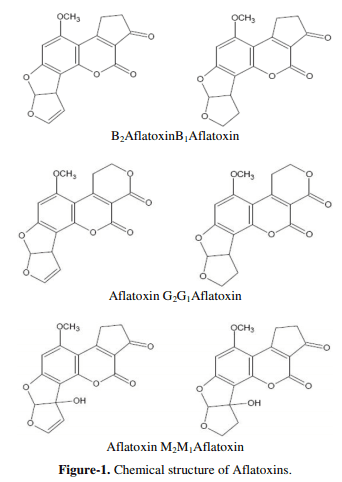Effect of Aflatoxins on Poultry Production and Control Methods of Destructive Influence
Aflatoxins are natural fungi toxins that have originated from Aspergillous fungi and secondary metabolites of moulds such as Aspergillus flavus and A. parasiticus. These toxins can be carcinogenic if they enter the body through food. Aflatoxin toxins can cause tissue necrosis, hepatic cirrhosis and liver cancer. Observed clinical signs in human including: regurgitation, cramp, acute hepatic lesions such as lipid changes, pulmonary edema, muscle tremors, coma, hysteria and death with brain edema and involvement of organs such as liver, kidney and heart. Among aflatoxins B1, B2, G1, G2, the most common ones is aflatoxin B1 that is very toxic. Aflatoxins can be found in many foods, for example, grains, oilseeds, spices, maize, groundnuts(peanuts), pistachios, red pepper, black pepper, dried fruit, figs, are substances that have a high risk of aflatoxin. But this dangerous toxin has been observed in a wide variety of food. There has been a chance of contaminant with aflatoxin M in milk, chesses and other dairy products; and Mycotoxins have had improper economical effects on farmers, consumers of agricultural and animal products and ultimately the entire of community.
Keywords: aflatoxin, poultry, immune, enzyme.



Aflatoxigenic fungi of concern in foods and feeds: A review, Journal of Food Protection. 58: 1395-1404.
Alameh A. and Razaghi Abianeh M. 2001. Mycotoxins. Amam Hossein University. First edition. pp. 39-94, 443- 476.
Alleroft E. D. 1964. Aspects of aflatoxicosis in farm animals and mycotoxins in food steffs. Journal Agriculture. 8(4): 153-162.
Alleroft E. D. 1964. Aspects of aflatoxicosis in farm animals and mycotoxins in food steffs. Journal Agriculture. 8(4): 153-162.
Bagherzadeh Kasmani, F., Karimi Torshizi, M. A., Allameh A. A. and Shariatmadari F. 2012b. A novel aflatoxin-binding Bacillus probiotic: performance, serum biochemistry and immunological parameters in Japanese quail. Poultry Science. 91(8): 1846-1853.
Bankole S. A. and Mabekoje O. O. 2004. Occurrence of aflatoxins and fumonisins in preharvest maize from southwestern Nigeria. Food Additives Contamination. 21: 251- 5.
Brown R. L., Chen Z. Y., Menkir A., Cleveland T. E., Cardwell K., KLinng J. and White D. G. 2001. Resistance to aflatoxin accumulation in kernels of maize in breds selected for ear rot resistance in West and Central Africa. Journal of Food Protection. 64(3): 396-400.
Diarra K. Nong ZG. Jie C. 2005. Peanut milk and peanut milk based products production: A review. Food Science and Nutrition. 45: 405-423.
Dudhe A., Datt C., Chahabra A. 1998. A cause of concern for human and animal health, Indian Dairyman, 50(6): 23- 30.
Fani Makki O. Afzali N. Allahresani A., Frouzanmehr M. 2013. The effect different levels of Aflatoxin B1 on intestinal length, blood parameters and immune system in broiler chickens. Journal of Veterinary Microbiology,26: 73-79.
FAO/WHO. 2010. Poultry Meat and Eggs. Agribusiness handbook. Viale delle Terme di Caracalla, 00153 Rome, Italy.
Galvano F. Piva A. Ritieni A. and Galvano G. 2001. Dietary strategies to counteract the effect of mycotoxins: A review. J. Food Prot. 64:120–131.
Goldblatt, L. A. 1976. A Series of monographs. Food Science and Technology, 12(4): 16-19, 261-275, 358-415.
Gourama H., Bullerman L. 1995. Aspergillus flavus and Aspergillus parasitic us: Aflatoxigenic fungi of concern in foods and feeds: A review, Journal of Food Protection, 58: 1395-1404.
Gowda N. K., Ledoux D. R., Rottinghaus G. E., Bermudez A. J. and Chen Y. C. 2009. Antioxidant efficacy of curcuminoids from turmeric (Curcuma longa Linn.) powder in broiler chickens fed diets containing aflatoxin B1. British Journal of Nature. 102: 1629-34.
Gupta K., Ramneek B. and Singh A. 2003. Immunomodulatory effects of aflatoxicosis and infectious bursal disease vaccination in broilers. Indian Veterinary journal. 80: 78-80.
Halliwell B. 2000. Why and how should we measure oxidative DNA damage in nutritional studies? How far have we come? The American Journal of Clinical Nutrition, 72(5): 1082-1087.
Hatfied DL.2001.Selenium: Its Molecular biology and Role in Human Healt. Norwood, MA: kluwer Academic Publisher. p. 352
Hawkins, L. K., Windham, G. L. and Williams, W. P. 2005. Effect of different postharvest drying temperatures on Aspergillus flavus survival and aflatoxin content in five maize hybrids. Journal of Food Protection, 68(7): 1521- 1524.
Hell K., Cardwell K. F., Setamou M. and PoehLinng H. M. 2000. The influence of storage practices on aflatoxin contamination in maize in four agroecological zones of Benin, West Africa. Journal of Stored Produce Research. 36: 365-382.
James M. j. 1997. Modern food microbiology. 5th Edition, Chapman and Hall. 71-73: 390-392.
Jelinek C. F., Pohland A. E. and Wood G. E. 1989. Worldwide occurrence of mycotoxins in foods and feedsan update. Journal-Association of Official Analytical Chemists. 72(2): 223.
Kermanshahi H., Hazegh A. R. and Afzali N. 2009. Effect of sodium bentonite in broilers fed diets contaminated with aflatoxin B1. Journal Animal. Veterinary Advance. 8: 1680-5593.
Marquardt R. R. 1996. Effects of molds and their toxins on livestock performance: a western Canadian perspective. Animal Feed Science and Technology. 58(1): 77-89.
Ortatatli M. and Oguz H. 2001. Ameliorative effects of dietary clinoptilolite on pathological changes in broiler chickens during aflatoxicosis. Research Veterinary Science. 71: 59-66.
Ozen H., Karaman M., Cigremis Y., Tuzcu M., Ozcan K. and Erda g. D. 2009. Effectiveness of melatonin on aflatoxicosis in chicks. Research Veterinary Science. 86: 485-489.
Park DL. 2002. Effect of processing on aflatoxin. Adv Exp Med Biol. 504:173-179.
Peng X. Zhang S. Fang J. Cui H. Zuo Z. Deng J.2014. Protective Roles of Sodium Selenite against Aflatoxin B1- Induced Apoptosis of Jejunum in Broilers. Int. J. Environ. Res. Public Health. 11: 13130-13143.
Raju MVLN, Devegowda G. 2000. Influence of esterified - glucomannan of performance and organ morphology, serum biochemistry and hematology in broilers exposed to individual and combined mycotoxicotoxicosis aflatoxin, ochratocin and T2 toxin. Br. Poult. Sci, 41: 640- 650.
Reddy K.V., Rao and Reddy V.R. 1989. Effect of aflatoxin on the performance of broiler chicks feed diet supplemented with vitamin A. Indian Journal of Animal Sciences. pp. 140-144.
Saeidi M.2005. Studying of Aflatoxin B1 metabolizing enzyms activity and its reaction with DNA in Rat Liver. Journal Medical Kowsar. 4: 241-246.
Shabani A., Dastar B., Khomeiri M., Shabanpour B. and Hassani S. 2010. Response of broiler chickens to different levels of nanozeolite during experimental aflatoxicosis. Journalof Biology Science. 10: 362-367.
Turner P.C. and Sylla A. 2005. Reduction in exposure to carcinogenic aflatoxins by postharvest intervention measures in West Africa: a community-based intervention study. The Lancet. 365: 950-956.
Umaya, R. S. and Manpal, S. 2013. Amelioration of Aflatoxicosis in Broilers. National Institute ofAnimal Nutrition and Physiology. pp. 1: 435.
Umaya R. S., Suresh K. P. and Parvatham R. 2011. Effect of Aflatoxin on Feed Conversion Ratio in Broilers: A Meta-analysis. Asian-Australasian Journal of Animal Sciences. 24: 1757-1762.
Wang J. S., Luo H., Billiam M., Wang J., Guan H. and Goldson T. 2005. Short term safety evaluation of processed calcium montmorillionite clay (NovaSil) in humans. Food Additives and Contaminants. 22: 270-279.
Williams I. H., Phillips T. D., Jolly P. E., Stiles J. K., Jolly C. M. and Aggarwal D. 2004. Human aflatoxicosis in developing countries: A review of toxicology, exposure, potential health consequences, and interventions. The American Journal of Clinical Nutrition. 80: 1106-1122.
Williams I. H., Phillips T. D., Jolly P. E., Stiles J. K., Jolly C. M. and Aggarwal D. 2004. Human aflatoxicosis in developing countries: A review of toxicology, exposure, potential health consequences, and interventions. The American Journal of Clinical Nutrition. 80: 1106-1122.
Yang C. F., Liu J., Wasser S., Shen H. M., Tan C. E. and Ong C.N. 2000. Inhibition of ebselenon aflatoxin B1- indued hepatocarcinogenesisin Fischer 344 rats. Carcinogenesis. 21: 2237- 2243.
Zaghini A. Martelli G. Roncada P. M. Simioli M. and Rizzi L. 2005. Mannanoligosaccharides and Aflatoxin B1 in Feed for Laying Hens:Effects on Egg Quality, Aflatoxins B1 and M1 Residues in Eggs,and Aflatoxin B1 Levels in Liver. Poult. Sci. 84:825-832.
Zhang J.S., Gao X.Y., Zhang L.D., Bao Y.P. 2001. Biological effects of a nano red elemental selenium. Biofactors. 15: 27-38.





